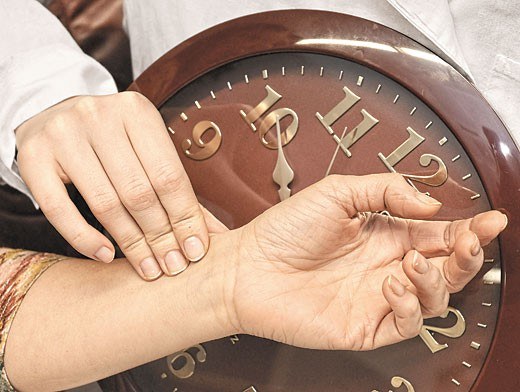For different ages there are different standards of heart rate alone. It depends also on the gender of the person. For baby is 140 beats/min, for children from birth to one year – 130 beats/min in age from one year to two years – 100 beats/min, from three to seven years – 95 beats/min, from eight to fourteen years – 80 beats/min.
For middle-aged men, the normal pulse is 60-80 BPM for women – 65-90 beats/min. the elderly the normal heart rate equals about 65 beats/min. If a person is sick, his heart rate increases to 120-150 beats/min.
The pulse rate of a healthy person varies during the day. Its lowest values are observed in the early morning and late evening. The highest values of the heart rate can be locked in the evening. In standing and sitting pulse rate is higher than in the supine position.
The probing pulse is determined by the middle, index and ring fingers of the right hand radial artery, located on the left hand. This artery can easily be found if you place your thumb horizontally on the wrist, below the first fold formed by the skin of her wrist.
Do not have to count the number of beats per minute, can be limited to 30 seconds, and then multiply the resulting figure by 2.
In addition to the number of beats per minute is supposed to be important and heart rate for each breathing cycle (exhalation, pause, inhalation). The norm for this cycle should have four to six beats. If the pulse is less frequent, or more often, it signals the violation of functions of any organs and gives a reason for seeking medical help.
An important indicator of the health of the body is a uniform pulse. In a healthy person it should be smooth in the fullness, strength of tension for 100 beats. The unevenness of the data pulse indicative of the disease.
If at rest or under light load, the pulse quickens and reaches more than one hundred beats per minute, this condition is called tachycardia and requires medical examination.
Low pulse less than 50 beats per minute indicate bradycardia and also require a medical examination.
Very slow and weak pulse may indicate heart failure. This condition is life threatening and requires emergency medical care.
During exercise the heart rate increases. The maximum number of heartbeats (heart rate) can be calculated by the following formula: 220 – person's age = maximum heart rate. So, if you play sports and you have, for example, 30 years, then your pulse during the classes should not be more numbers 190. Within 10 minutes after termination of the load pulse must come to normal.
